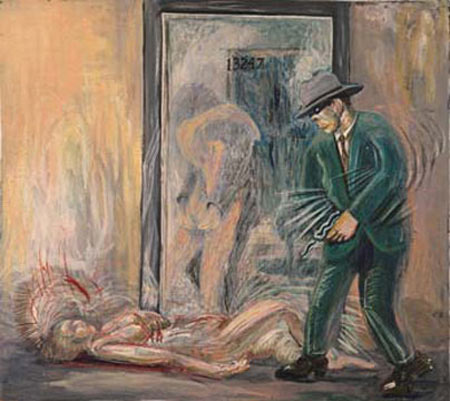
This Charles Garabedian retrospective spans 50 years of creative production starting in the 1960s and distills key themes in the work of the former UCLA teacher and internationally noted, tenaciously figurative artist.
Garabedian is not alone in yoking figuration to Western humanism. Judeo-Christian, Greek, Renaissance and Enlightenment traditions historicize this link via idealized bodies, technological perfection, ordered space and a host of other tropes for reasoned man, who is good because he is beautiful and beautiful because he is good. Think of Michelangelo’s smooth and tensile “David.” Helixed into this idea as antithesis is that other humanism - the actually human. Think here of Scopas’ late Classical "Boxer” carved from pitted, expressive surfaces, aging and unsure of what comes next for him.
Art typically chooses one or the other of these poles: the ordered/grid/God/certainty side, or the splattered/random/Satan side (the word “satan,” Cabalists note, means nothing more than “one who doubts”). If art pretends that the perfect David and the has-been Boxer never comingle, only take successive turns in our personal and collective psyches, then for over 50 years through all manner of socio-aesthetic cycles, Garabedian’s art has been asserting the opposite.
The exhibition press release asks, why Garabedian and why now? For an answer we need to look back. There’s an interesting if not casual connection between social forces and our interest in both the figure and humanism. The economic free-fall of the 1980s saw the rise of Neo Expressionism. In the mid-90s, with its looming government stand-down and ditsy intern in soiled blue dress, art speculators could not get enough of overwrought representation by Van Gogh, Frida Kahlo and Lucien Freud. Today extremist Islamic bombers kill Moslems women and kids, world powers are cowered into honesty by some guy with a laptop, and Wall Street hoodlums in Gucci make obscene profits then somehow siphon billions more in tax dollars because life as we know it rests on their golden parachutes. In these our very own preposterous times art seems once again to gravitate toward elegant and hard hitting painted bodies: witness Anselm Keifer at Gagosian, Willem de Kooning at L&M, a selection of key figurative artists in a curated show at LA Louver, and in New York MOMA has highlighted early figures by Matisse. Graduate students are still committed to Joseph Beuys, but they are also are demanding to learn how to paint a poignant face.
Generalizations are odious but it does appear that as we wonder who and what we are, as our petty illusions, hubris and consumption hit a periodic wall, we return to the figure to figure things out. . .
Garabedian has had a career engagement with figuration as the arena wherein humanism sorts out its psychic, social, daily and mythic conundrums. Culture tends to notice these moments when the sewage hits the fan; Garabedian lives them as his sole artist diet.
Biblical and Homeric storylines abound here because these ancient views were the first to imagine the hero’s path and the fool’s labyrinth as mutually exclusive and morally distinct, so it makes perfect sense that Garabedian mines these. And it is true that his conflations of certainty and doubt can get cloying and obvious (“Chinese Mr. Hyde” (1975), “Adam and Eve” (1974) as disembodied legs topped with clouds). But much work from the 80s — when his artistic community temporarily shared and supported his vision — is stunning.
“Dead” invokes classical one point perspective with a figure radically foreshortened, head toward viewer, legs sweeping deeply into the plane to recall dramatic experiments in spatial logic by Mantegna and Uccello. Garabedian seems to use this allusion to Renaissance systems deliberately, only to overlay it with a good dose of Kirchner. In this work, as in “Study for Iliad,” we see Die Brucke’s crude limbs “severed” by intervening abstract planes, and opaque flesh tones that hack out raw and lumpy torsos. In “Prehistoric Figure (Man with Green Circle)” an otherwise heroic nude can’t hold his contraposto because joints fold illogically, wobble and defy anatomy. “Decay’s” female body lies diagonally on a platform like a long pose drill from life drawing class, except that here an aberrant plane shift reveals her anus. The beautiful “Channel Swimmer” (2006) shows a body floating fetal-like, its spindly arms stroke hard but cannot keep the sinking head above the water line.
Kirchner, Schiele, Schnabel, Cucci rejected the whitewashed side of humanism by having their figures jump in the dirty mosh pit head long; Garabedian never lets his figures fully lose their grace, they totter on a threshold just outside abjection.
